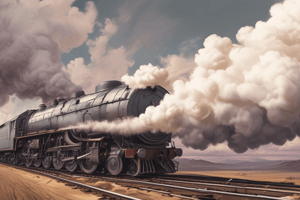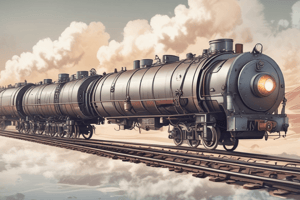Podcast
Questions and Answers
What is referred to as the sensible heat in the heating process of water?
What is referred to as the sensible heat in the heating process of water?
- Heat required to vaporize water
- Heat absorbed during freezing
- Heat released during condensation
- Heat to raise temperature from 0° C to saturation temperature (correct)
What is the term used for the temperature at which water begins to boil at a stated pressure?
What is the term used for the temperature at which water begins to boil at a stated pressure?
- Freezing point
- Thermal threshold
- Critical temperature
- Saturation temperature (correct)
What happens to the temperature of water during the phase change from liquid to vapor at saturation temperature?
What happens to the temperature of water during the phase change from liquid to vapor at saturation temperature?
- It continuously increases
- It remains constant (correct)
- It decreases significantly
- It fluctuates rapidly
Which term describes the heat energy required to convert water at its saturation temperature into steam?
Which term describes the heat energy required to convert water at its saturation temperature into steam?
When steam is in contact with water, how is it classified?
When steam is in contact with water, how is it classified?
What is the result of supplying heat to saturated steam at constant pressure?
What is the result of supplying heat to saturated steam at constant pressure?
The heat added to a substance that does not cause a temperature increase but results in a phase change is known as:
The heat added to a substance that does not cause a temperature increase but results in a phase change is known as:
What process is described when dry steam is heated beyond its saturation temperature?
What process is described when dry steam is heated beyond its saturation temperature?
What phase does water exist in when it is at 0° C before any changes occur?
What phase does water exist in when it is at 0° C before any changes occur?
During the vaporization process, which phase of water is formed before it becomes pure steam?
During the vaporization process, which phase of water is formed before it becomes pure steam?
What does not change in a pure substance during a thermodynamic process, despite phase changes?
What does not change in a pure substance during a thermodynamic process, despite phase changes?
Which of the following laws do vapors not obey?
Which of the following laws do vapors not obey?
What is the phase of water called when it is heated beyond the boiling point?
What is the phase of water called when it is heated beyond the boiling point?
What is the state of water in a cylinder with a piston at 0° C, with weight exerting pressure on it?
What is the state of water in a cylinder with a piston at 0° C, with weight exerting pressure on it?
What happens to water during the process of melting?
What happens to water during the process of melting?
What is defined as the vapor of water?
What is defined as the vapor of water?
What is a primary function of the bucket or barrel calorimeter?
What is a primary function of the bucket or barrel calorimeter?
What component of the bucket calorimeter prevents heat loss?
What component of the bucket calorimeter prevents heat loss?
How does the separating calorimeter collect water droplets from wet steam?
How does the separating calorimeter collect water droplets from wet steam?
What happens when steam is passed through the water in the bucket calorimeter?
What happens when steam is passed through the water in the bucket calorimeter?
What role does the perforated tray in the separating calorimeter play?
What role does the perforated tray in the separating calorimeter play?
What is essential for minimizing errors in the bucket calorimeter?
What is essential for minimizing errors in the bucket calorimeter?
What is the primary heat transfer method in the bucket calorimeter?
What is the primary heat transfer method in the bucket calorimeter?
What is true about the construction of the separating calorimeter?
What is true about the construction of the separating calorimeter?
What is the term used to describe the steam that has been heated beyond its saturation temperature?
What is the term used to describe the steam that has been heated beyond its saturation temperature?
Which statement accurately describes the relationship between superheated steam and dry saturated steam?
Which statement accurately describes the relationship between superheated steam and dry saturated steam?
What is the disadvantage of using superheated steam in turbines?
What is the disadvantage of using superheated steam in turbines?
What is the completeness of a steam's saturation temperature in the context of wet steam?
What is the completeness of a steam's saturation temperature in the context of wet steam?
The dryness fraction of wet steam is always:
The dryness fraction of wet steam is always:
What do you call the ratio of the actual dry steam present in a known quantity of wet steam to the total mass of that wet steam?
What do you call the ratio of the actual dry steam present in a known quantity of wet steam to the total mass of that wet steam?
What issues can arise from the initial and maintenance costs associated with superheating?
What issues can arise from the initial and maintenance costs associated with superheating?
What does the wetness fraction of steam indicate within a certain quantity of wet steam?
What does the wetness fraction of steam indicate within a certain quantity of wet steam?
What is the primary function of the throttling calorimeter?
What is the primary function of the throttling calorimeter?
What must be true of steam for the throttling calorimeter to be effectively used?
What must be true of steam for the throttling calorimeter to be effectively used?
Which components are essential for the construction of a throttling calorimeter?
Which components are essential for the construction of a throttling calorimeter?
Why is a combined separating and throttling calorimeter used?
Why is a combined separating and throttling calorimeter used?
What happens to steam as it passes through the throttle valve?
What happens to steam as it passes through the throttle valve?
Which measurement is taken after steam is throttled?
Which measurement is taken after steam is throttled?
What is indicated by the scale in the separating calorimeter?
What is indicated by the scale in the separating calorimeter?
In a combined separating and throttling calorimeter setup, what happens to the steam after it leaves the separating calorimeter?
In a combined separating and throttling calorimeter setup, what happens to the steam after it leaves the separating calorimeter?
Flashcards are hidden until you start studying
Study Notes
Introduction to Steam Properties
- A perfect gas maintains phase during thermodynamic processes; however, a pure substance like water changes phases (ice, water, steam) without altering its chemical composition.
- Steam, the vapor of water, forms as water is heated beyond its boiling point, resulting in a mixture of water and steam during vaporization.
Difference between Steam and Gas
- Vapors, unlike ideal gases, do not follow Boyle's and Charles's laws, making their behavior distinct.
Steam Formation Process
- Water at 0°C in a piston-cylinder setup will undergo heating, increasing temperature until the boiling point is reached.
- The saturation temperature marks the point at which water begins to boil under constant pressure.
Heat Transfer in Water
- Sensible heat, or enthalpy of the liquid ((h_f)), is required to raise water temperature to saturation.
- Continuous heat supply at saturation results in phase change from liquid to gas; this energy is termed latent heat ((h_{fg})), with no temperature rise during this process.
- Wet steam contains both liquid water and vapor at saturation conditions, showing the significance of enthalpy.
Superheating of Steam
- Superheated steam is formed when additional heat is applied to saturated steam, raising temperature and volume beyond saturation levels.
- The degree of superheat is the difference between superheated and saturation temperatures.
Advantages and Disadvantages of Superheated Steam
- Advantages:
- Higher energy content increases work capacity.
- Reduces condensation during turbine expansion, improving economy.
- Enhances boiler thermal efficiency.
- Disadvantages:
- High temperatures complicate lubrication in turbines.
- Increased costs for initial setup and maintenance of superheaters.
Types of Steam
- Wet Steam: A mixture of water droplets and steam at thermal equilibrium.
- Dryness Fraction (x): Ratio of dry steam in wet steam; can range from 0 (completely wet) to 1 (completely dry).
- Wetness Fraction: Complement of dryness fraction, indicating the amount of liquid present.
Calorimeters for Measuring Dryness Fraction
- Bucket or Barrel Calorimeter: Measures steam condensation in a water-filled chamber, with insulated design to minimize heat loss.
- Separating Calorimeter: Separates liquid water from steam using inertia on perforated trays, measuring the resulting liquid mass.
- Throttling Calorimeter: Measures steam properties before and after throttling to lower pressure using a throttle valve; suitable for dryness fractions above 0.95.
- Combined Separating and Throttling Calorimeter: Uses a series of both separating and throttling methods to determine steam properties when dryness fraction is below 0.9.
Key Components of Calorimeters
- Bucket calorimeters feature insulation to maintain temperature.
- Separating calorimeters utilize inertia to differentiate between vapor and liquid phases effectively.
- Throttling calorimeters contain pressure and temperature measuring instruments to ensure accurate readings post-throttling.
Conclusion
- Understanding steam properties and the relevant calorimetry techniques is essential for effective energy management in thermodynamic systems, particularly in engineering disciplines related to fluid mechanics and thermal processes.
Studying That Suits You
Use AI to generate personalized quizzes and flashcards to suit your learning preferences.





